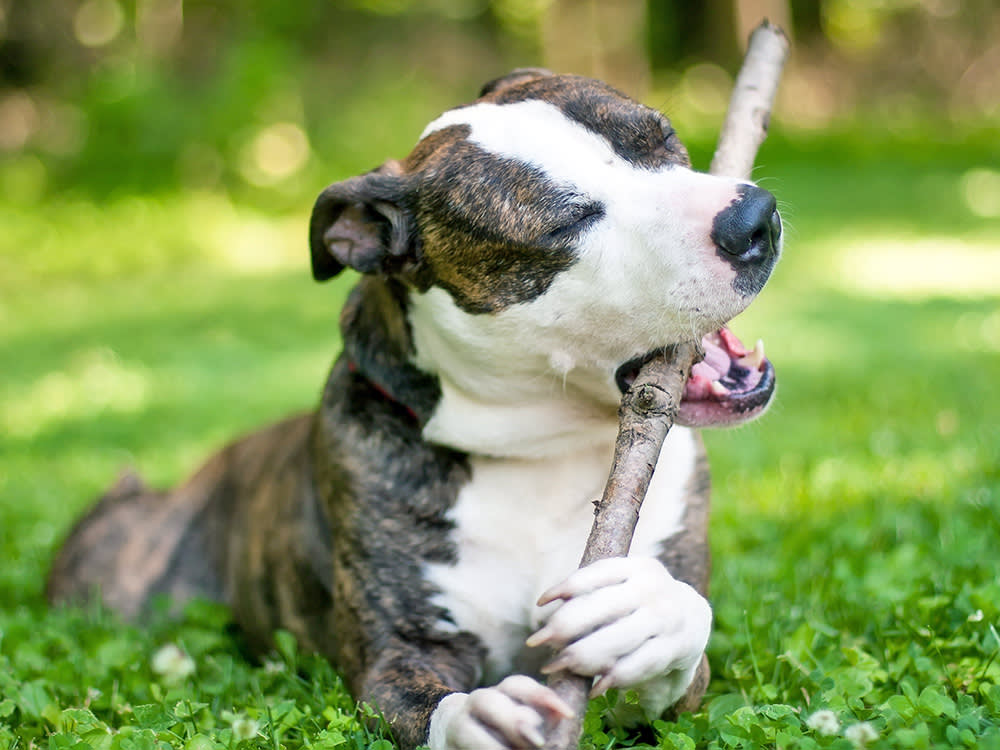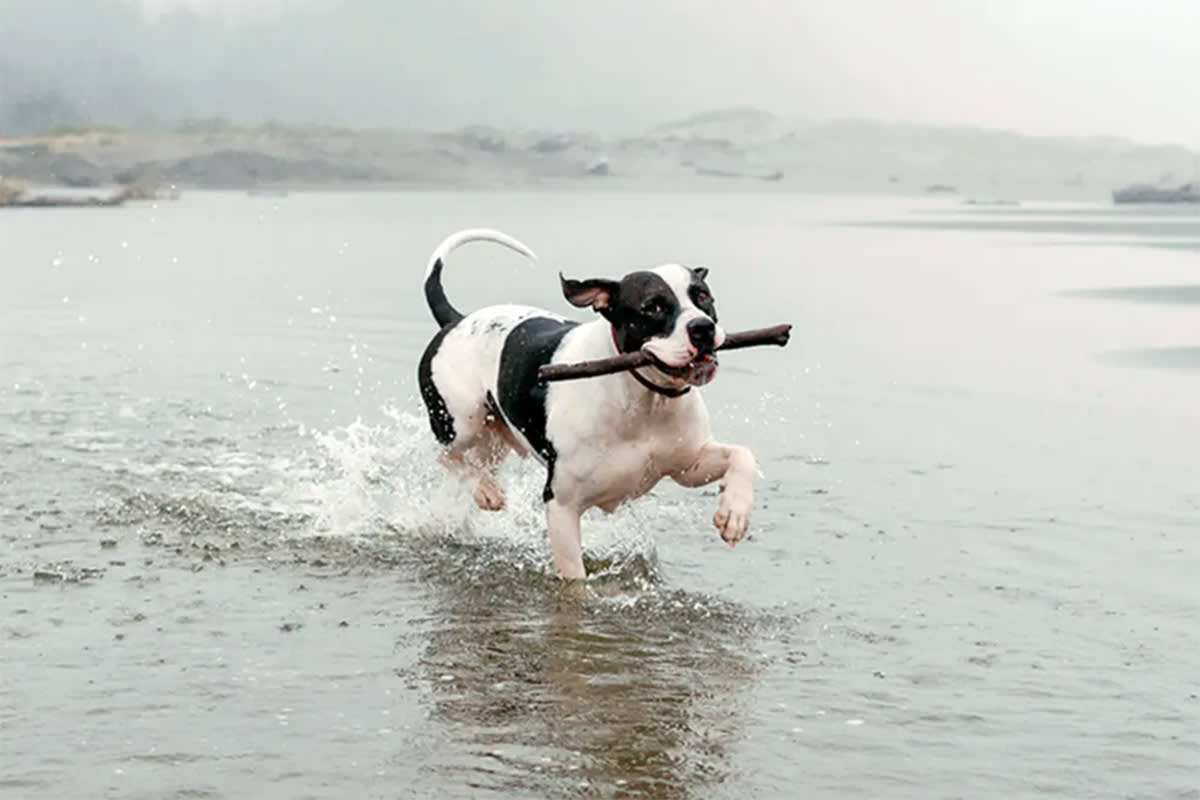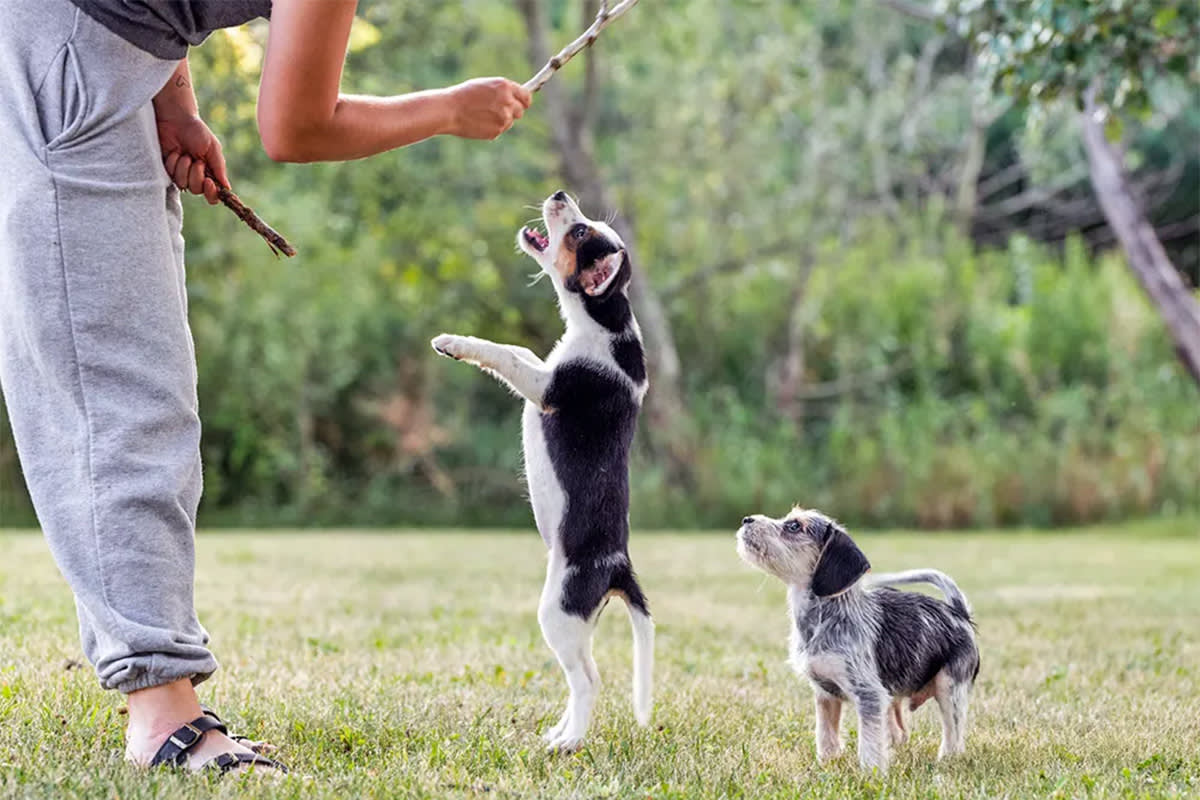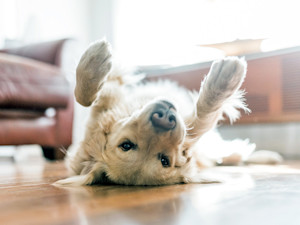Why Are Dogs Obsessed With Chewing Sticks?
They definitely think Taylor Swift’s “Wood” is about their favorite backyard twig stash.
It’s hard to name a more iconic duo than a dog and a stick. Whether they’re playing fetch or looking for something to chew on, many pups love the feeling of wood between their teeth. Unfortunately, there’s more to a stick than just its earthy scent.
As cute as this classic dog behavior might be, chewing on wood, specifically, can also pose a real danger to your pup. “Chewing is normal behavior for dogs,” says Dr. Michael Hyder, medical director for VEG ER for Pets in Palo Alto, California, “but not everything they want to chew is safe.”
Dogs might love to chow down on some wood, but the risk of splinters is very real — and even that could be the least of your worries. Sticks can injure gums, get lodged in teeth, and wreak all sorts of terrifying havoc when ingested. For that reason alone, it might be time to help them kick the habit.
Why do dogs chew on sticks?
There are many reasons why our dogs might chew on sticks, according to Dr. Hyder. Twigs are often easy to find, mimic the shape and texture of bones, and also have a nice, woodsy aroma. Plus, they satisfy the natural canine urge to chew on everything in sight.
How much do you spend on your pet per year?
“Chewing is a very normal behavior for our dogs,” says Dr. Sarah Cortright, medical director for Underdog Community Projectopens in new tab in Los Angeles. Often, she says, “It’s kind of instinctual.”
Dogs might chew to alleviate stress or boredom, and puppies like to gnaw on everything in sight while teething to ease the pain. But whatever draws our dogs to munch on wood, specifically, it’s best to redirect that energy in a safer direction.
Is chewing on sticks dangerous?
In a word, yes. According to Dr. Hyder, “Chewing on sticks can lead to serious health problems or even emergencies.” That’s because unlike toys specifically designed for chewing, sticks are irregularly shaped, can easily break apart into pieces or splinters, and could also carry mold, pesticides, or bacteria.
The biggest health risks from playing with sticks can include:
Splinters or pieces stuck in the gums or mouth
Punctures or cuts in the mouth or throat
Intestinal blockage from swallowed wood
Infections from bacteria or fungi on the wood
Choking or gagging on large or awkward pieces
“I know dogs love sticks,” Dr. Cortright says. “It’s so unfortunate.” But even just the act of running with a stick in their mouth can put our pups in real dangerous territory. Dr. Cortright adds, “We’ve seen a lot of, like, penetrating wounds from dogs running with sticks in their mouth.”
That said, Dr. Cortright also cautions pet parents against hard chew toys — even the many, many options offered at pet stores, like antlers and Nylabones. As much as dogs might enjoy those products, she says, “We see a lot of medical issues that can arise from these kinds of chewing behaviors.” In general, she says, if you cannot make an indent in a toy with your fingernail, it’s probably too hard for your pup to bite down on.
On top of choking or ingestion hazards, Dr. Cortright says, hard toys and sticks can also cause dental issues like fractures. “The same way that we could break our teeth on a hard candy,” she says, “we wouldn’t be chewing on sticks that would injure our teeth,” she says. “Especially with how vigorously some of these dogs are chewing on those things.”
Do certain breeds like chewing on sticks more than others?
High-energy breeds tend to be the most likely to chew on sticks during play. That can include Labradors and Golden Retrievers, Terriers, and working and herding breeds. Anecdotally, Dr. Cortright says Golden Retrievers, Golden Doodles, Labradors, and similar dogs land in the ER most for chewing on unsanctioned items.
“There are some large-breed dogs that have no interest in chewing,” Dr. Cortright says, and plenty of small dogs have their own passion for chew toys. But still, “it tends to be the larger dogs.” To Dr. Cortright, “it’s a combination of breed and also just the individual.”
It’s not just breed, either. According to Dr. Hyder, puppies and adolescent dogs are more likely to chew than seniors. That said, “even older dogs may chew if they are bored, anxious, or under-stimulated.” As with most things, questionable nibbling habits know no age limit.
What to do if you catch your dog chewing on wood
If you catch your dog going to town on a stick, don’t panic or scold them. Instead, Dr. Hyder says, “Stay calm, redirect, and replace the object with something safer.”
If your dog knows a command like “drop it” or “leave it,” these moments are a great time to use them. If not, Dr. Cortright recommends against pulling or yanking on the stick, which could cause it to break. Instead, try to gently remove it. Once your dog drops the stick, reward them with a treat, or with a more suitable toy like a rubber chew toy or a ball.
If your dog tends to play in a backyard, Dr. Hyder recommends clearing out debris regularly, especially after storms or yard work. “Prevention and training are key,” he says. “Reinforce good behavior with praise and treats when your dog ignores or drops a stick.”
When to see the vet
Once you’ve convinced your dog to let go of their new favorite stick, it’s important to inspect their mouth and look for signs of injury. If you believe your dog injured their mouth or ingested part of the stick, that should trigger an immediate vet visit.
Symptoms to watch for include:
Coughing, trouble breathing, gagging, or pawing at the mouth
Refusal to eat or drink
Drooling or bleeding from the mouth
Bad breath or signs of infection
Vomiting or signs of abdominal pain
Lethargy, discomfort, or behavioral changes
“Even if the issue seems small, wood-related injuries can become serious quickly,” Dr. Hyder says. “When in doubt, it's always safest to have a vet take a look.”
To the degree your dog will tolerate it, Dr. Cortright recommends looking at their teeth and gums. “If something’s bleeding,” she says, “you’ll see it pretty obviously, because gums bleed a lot.” A small scrape or scratch should heal quickly, but if the bleeding continues or worsens, or if your dog develops a nosebleed or their eyes begin to look “off,” that could signal that debris has dislodged from one area of the mouth and moved to another space in the head.
Beyond the mouth, observe your dog’s face and neck and watch for labored breathing or coughing. In those cases, Dr. Cortright says, call your vet immediately.
“Our dogs are amazing at hiding their pain and discomfort,” Dr. Cortright says. “So my advice is, if you have the time and you're concerned, being cautious with a creature that cannot tell us what's wrong is always advised over waiting.”









